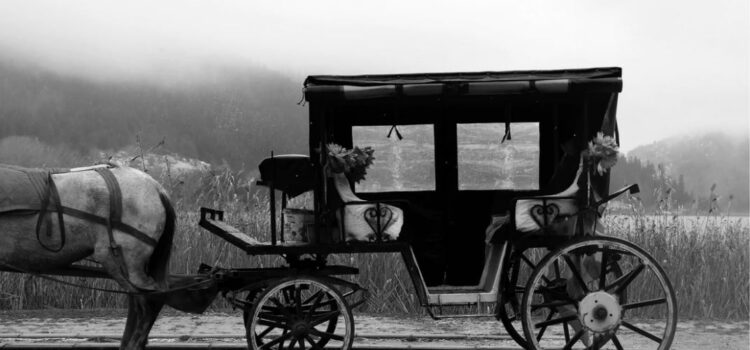

This article is an excerpt from the Shortform book guide to "The Tattooist of Auschwitz" by Heather Morris. Shortform has the world's best summaries and analyses of books you should be reading.
Like this article? Sign up for a free trial here .
In The Tattooist of Auschwitz, what happened to Lale and Gita after Auschwitz fell? How did they manage to find each other?
After Auschwitz fell, Gita made it back to her hometown of Bratislava and Lale went back to his sister in Krompachy. Lale’s sister told him not to come back until he had Gita with him. So he set out again to find the love of his life.
Keep reading to find out what happened to Lale and Gita after Auschwitz fell.
Reclaiming the Life Left Behind
While on the run after the Auschwitz escape, Gita and a group of Polish girls are helped by a Russian guard. He arranges for transport to take the girls to the house of one of the Polish girls’ sister. The sister’s place in Krakow is crowded with other displaced people. None of them has any possessions or money, so they each steal one item a day from a market and make a meal for everyone. On one of these market trips, Gita hears someone speaking in her regional dialect. She approaches him and learns that he drives a produce truck to and from her hometown of Bratislava every week. Gita asks if she can catch a ride, and he agrees.
Gita and the Polish girls struggle as they say goodbye. They’ve been through so much together. But they wish her well and see her off at the market. Gita doesn’t know what she will find at home. She knows her parents and sister are dead, but she hopes that at least one brother might still be alive.
Reuniting With Family After Auschwitz
In Bratislava, Gita stays in another apartment cramped with people, most of them camp survivors. She registers with the Red Cross, as many do in hopes of finding lost family and friends. On an afternoon not long after arriving, Gita looks out the window and panics at the sight of two Russian soldiers sneaking onto the property. But then she realizes they are her brothers. She rushes to them and jumps in their arms.
The reunion is short-lived. The brothers are partisan fighters for the Russians, and people are wary of soldiers these days. The siblings sit and talk for as long as they can. Gita doesn’t tell them about the rest of their family, not wanting to dampen their small amount of time together.
Another familiar face enters the streets of Bratislava. After a long journey, Lale finally steps off the train in the city where he once lived. His trip away from the Russians had been anything but easy. A Russian soldier took his bicycle not long after Lale left town, so he walked through the night until he came upon a train station.
The train was an unfriendly sight, but after he saw that the carriages were for travelers, he purchased a ticket with one of the gems. The train attendant saw Lale’s tattoo and told him where to sit so he wouldn’t be bothered. He also gave Lale a sandwich and thermos of coffee. Both men had tears in their eyes when Lale thanked him. When the train crossed the border to Slovakia, an official asked for Lale’s papers. Lale showed him the only identification he had—his tattoo. He told the official he was Slovak. The official welcomed him home.
In Bratislava, Lale wanders the city thinking about what his life for the past three years was supposed to have been like here. Much of the city is destroyed, and he realizes there is nothing left for him there. He decides to head to his parents’ home in Krompachy. Without realizing that Gita is so close, Lale sets out to travel the 250 miles home. After four days of walking and hitching rides, he finally turns down his childhood street. He stands across from the house, now in a state of disrepair, wondering if there is anyone left to find.
Lale in Krompachy
An old woman comes out of the house Lale is standing in front of. She carries a heavy wooden spoon and tries to chase him off. Lale explains that he used to live in the house across the street. The woman looks at him closely, and it suddenly hits her. Lale and the woman, Mrs. Molnar, embrace, neither having recognized the other after so many hard years. When she tells Lale that his sister Goldie still lives there, Lale runs to the door and bangs until it opens. Goldie faints when she sees her brother.
When Goldie regains consciousness, she cries in Lale’s arms. Neither has the ability to speak for a long time. Later, she tells him about the rest of their family. His parents were taken a few days after Lale left, but she doesn’t know where they went. Max, his brother, was a partisan fighter and died battling the Germans. Max’s wife and two boys were also taken, but again, she doesn’t know any more. Goldie married a Russian businessman and changed her name to Sokolov. He was gone on a trip.
Lale is less forthcoming with Goldie. He doesn’t tell her about the real nature of the camps or conditions. He merely says he was at a labor camp in Poland and now he’s back. Lale tells Goldie and Mrs. Molnar about Gita and his belief that she is still out there somewhere. He says he doesn’t know where she went after Auschwitz fell or where to even start looking for her.
Lovers Reunite After Auschwitz
Goldie and Mrs. Molnar are captivated by this love story and urge him to leave at once to begin his search. They make food for his journey, and Lale buys a cart with one horse. He’s sad to say goodbye to Goldie so soon, but she tells him not to come back until Gita is with him.
Lale travels across the country for three days and finally makes it back to Bratislava. By now, he’s learned that many survivors are traveling to the city by train, so he heads to the station. For two weeks, Lale checks each arriving passenger but doesn’t find Gita. Occasionally, he comes across another Birkenau woman, but none know of his love. One of the station workers suggests that Lale register Gita with the Red Cross. He figures it’s as good a plan as any and heads toward the main district.
It’s a lovely afternoon when Gita and two friends see a strange horse-driven cart coming toward them on the street. There’s a man standing in the back, a man who looks familiar. The cart slows, and so does her heartbeat. As the man climbs down, Gita moves away from her friends to get a closer look. When she sees Lale, she steps forward, but he does not move. It is only after Lale hears Gita’s voice that he falls to his knees.
Gita tells her friends that Lale is the man she always talks about but couldn’t find after Auschwitz fell. Her friends take the horse and cart away, giving them some privacy. Gita kneels before Lale, and he asks her to marry him. When she says yes, his strength returns, and he picks her up and kisses her. Wrapped in each other’s arms, they walk down the street and mix with the crowd, just another pair of lovers out for a walk.

———End of Preview———
Like what you just read? Read the rest of the world's best book summary and analysis of Heather Morris's "The Tattooist of Auschwitz" at Shortform .
Here's what you'll find in our full The Tattooist of Auschwitz summary :
- How a man used tattooing skills to stay alive at Auschwitz-Birkenau
- How Lale Sokolov fell in love in these unusual circumstances
- How Lale goes from concentration camp to Russian prisoner before finding freedom






